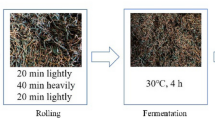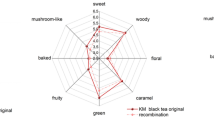Abstract
Wild black tea varieties with almond odors were found in Guangdong, China. Few previous studies have investigated their metabolic profile during processing. Herein, we assessed the variations in the chemical components including the volatile flavor compounds and nonvolatile flavor components during black tea processing. Benzaldehyde was responsible for the almond odor and could be used as an indicator for identifying black tea varieties with almond odors because of its relative stability. The contents of aromatic compounds with floral, sweet, and honey-like aromas, such as (E)-geraniol, phenylethyl alcohol, benzyl alcohol, β-ionone, α-terpineol, and (Z)-geraniol, were higher in the final drying process than they were in the plucking stage. However, the contents of β-linalool and its oxides and methyl salicylate tended to be lower in the dried black teas. PCA showed that 88.41% of the variation between the aromatic compounds and their odor attributes can be explained by PC1 and PC2. The almond flavor samples were differentiated from the control samples according to PCA. The contents of nonvolatile flavor components such as tea polyphenols, amino acids, soluble carbohydrates and caffeine were significantly lower in the dried black teas. The sensory evaluation suggested that XR black teas had strong and lasting almond odors, while DX-8 had floral and medicinal odors.




Similar content being viewed by others
Abbreviations
- VFCs:
-
Volatile flavor compounds
- HS-SPME:
-
Headspace solid-phase microextraction
- GC–MS:
-
Gas chromatography-mass spectrometry
- DVB/CAR/PDMS:
-
Divinylbenzene/Carboxen/Polydimethylsiloxane
- PCA:
-
Principal Component Analysis
- HPLC:
-
High-performance liquid chromatography
- TIC:
-
Total ion chromatography
- C:
-
Catechin
- EC:
-
Epicatechin
- GC:
-
Gallocatechin
- EGCG:
-
Epigallocatechin gallate
- EGC:
-
Epigallocatechin
- GCG:
-
Gallocatechin gallate
- ECG:
-
Epicatechin gallate
- PPO:
-
Polyphenol oxidase
- PO:
-
Peroxidase
- TFs:
-
Theaflavins
- TRs:
-
Thearubigins
- TBs:
-
Theobromine
References
Kim Y, Goodner KL, Park JD, Choi J, Talcott ST (2011) Changes in antioxidant phytochemicals and volatile composition of Camellia sinensis by oxidation during tea fermentation. Food Chem 129:1331–1342
Ho CT, Zheng X, Li S (2015) Tea aroma formation. Food Sci Hum Wellness 4:9–27
Ravichandran R, Parthiban R (1998) The impact of processing techniques on tea volatiles. Food Chem 62(3):347–353
Yang ZY, Baldermann S, Watanabe N (2013) Recent studies of the volatile compounds in tea. Food Res Int 53(2):585–599
Tuan HQ, Thinh ND, Tu NTM (2017) Changes in composition of flavour precursor amino acid in leaves of tea (Camellia sinensis) during orthodox black tea processing. J Sci Technol 55(1):1–7
Lin SY, Lo LC, Chen IZ, Chen PA (2016) Effect of shaking process on correlations between catechins and volatiles in oolong tea. J Food Drug Anal 24:500–507
Zheng XQ, Li QS, Xiang LP, Liang YR (2016) Recent advances in volatiles of teas. Molecules 21(3):338
Saijō R, Kuwabara Y (1967) Volatile flavor of black tea. Part I. formation of volatile components during black tea manufacture. Agric Biol Chem 31(4):389–396
Ravichandran R, Parthiban R (2000) Lipid occurrence, distribution and degradation to flavour volatiles during tea processing. Food Chem 78:7–13
Selvendran RR, Reynolds J, Galliard T (1978) Production of volatiles by degradation of lipids during manufacture of black tea. Phytochem 17:233–236
Kinoshita T, Hirata S, Yang ZY, Baldermann S, Kitayama E, Matsumoto S, Suzuki M, Fleischmann P, Winterhalter P, Watanabe N (2010) Formation of damascenone derived from glycosidically bound precursors in green tea infusions. Food Chem 123:601–606
Wang DM, Yoshimura T, Kubota K, Kobayashi A (2000) Analysis of glycosidically bound aroma precursors in tea leaves. 1. Qualitative and quantitative analyses of glycosides with aglycons as aroma compounds. J Agric Food Chem 48:5411–5418
Duan Z, Liu B, Wang Y, Xie J, Sun X, Song W, Ai B, Ma L (2012) Studies on the diversity of chemical constituents of wild tea plants in Yunnan. Hunan Agric Sci 19(102–104):108 (in Chinese)
Jiang XH, Wu HL, Chen D, Qiao XY (2014) Sensory quality evaluation and biochemical composition of Luokeng black tea. Chin Agric Sci Bull 30(31):126–131 (in Chinese)
Wu HL, Huang WJ, Chen ZJ, Chen Z, Shi JF, Kong Q, Sun SL, Jiang XH, Chen D, Yan SJ (2019) GC-MS-based metabolomic study reveals dynamic changes of chemical compositions during black tea processing. Food Res Int 120:330–338
Lv HP, Zhong QS, Lin Z, Wang L, Tan JF, Guo L (2012) Aroma characterisation of Pu-erh tea using headspace-solid phase microextraction combined with GC/MS and GC–olfactometry. Food Chem 130(4):1074–1081
Xu YQ, Liu PP, Shi J, Gao Y, Wang QS, Yin JF (2018) Quality development and main chemical components of Tieguanyin oolong teas processed from different parts of fresh shoots. Food Chem 249:176–183
Xu YQ, Hu XF, Tang P, Jiang YW, Yuan HB, Du QZ, Yin JF (2015) The major factors influencing the formation of sediments in reconstituted green tea infusion. Food Chem 172:831–835
Wang X, Zeng L, Liao Y, Zhou Y, Xu X, Dong F, Yang Z (2019) An alternative pathway for the formation of aromatic aroma compounds derived from l-phenylalanine via phenylpyruvic acid in tea (Camellia sinensis (L.) O. Kuntze) leaves. Food Chem 270:17–24
Yao SS, Guo WF, Lu Y, Jiang YX (2005) Flavor characteristics of Lapsang Souchong and smoked Lapsang Souchong, a special Chinese black tea with pine smoking process. J Agric Food Chem 53(22):8688–8693
Yin J, Xu Y, Yuan H, Luo L, Qian X (2009) Cream formation and main chemical components of green tea infusions processed from different parts of new shoots. Food Chem 114(2):665–670
Gong SY, Zhao Y, Lu C, Liu X, Guo Y, Zhang Y, Chen P, Zou X, Guo H, Wu J, Zhao L, Shen W, Dai Q (2018) Methodology for sensory evaluation of tea. National Standard of the People's Republic of China, Beijing (in Chinese)
Lasekan O, Abbas K (2011) Analysis of volatile flavour compounds and acrylamide in roasted Malaysian tropical almond (Terminalia catappa) nuts using supercritical fluid extraction. Food Chem Toxicol 48(8–9):2212–2216
Xiao L, Lee J, Zhang G, Ebeler SE, Wickramasinghe N, Seiber J, Mitchell AE (2014) HS-SPME GC/MS characterization of volatiles in raw and dry-roasted almonds (Prunus dulcis). Food Chem 151:31–39
Jolvis Pou KR (2016) Fermentation: the key step in the processing of black tea. J Biosyst Eng 41(2):85–92
Remaud G, Debon AA, Martin YL, Martin GG, Martin GJ (1997) Authentication of bitter almond oil and cinnamon oil: application of the SNIF-NMR method to Benzaldehyde. J Agric Food Chem 45(10):4042–4048
Wang LF, Lee JY, Chung JO, Baik JH, So S, Park SK (2008) Discrimination of teas with different degrees of fermentation by SPME–GC analysis of the characteristic volatile flavour compounds. Food Chem 109(1):196–206
Rawat R, Gulati A, Kiranbabu G, Acharya R, Kaul V, Singh B (2007) Characterization of volatile components of Kangra orthodox black tea by gas chromatography-mass spectrometry. Food Chem 105(1):229–235
Van Gemert LJ (2011) Odour thresholds compilations of odour threshold values in air, water and other media (2nd enlarged and revised ed.). Utrecht, Netherlands
Owuor PO, Obanda M, Nyirenda HE, Mandala WL (2008) Influence of region of production on clonal black tea chemical characteristics. Food Chem 108:263–271
Schuh C, Schieberle P (2006) Characterization of the key aroma compounds in beverage prepared from Darjeeling black tea: quantitative differences between tea leaves and infusion. J Agric Food Chem 54(3):916–924
Baldermann S, Yang ZY, Katsuno T, Tu VA, Mase N, Nakamura Y, Watanabe N (2014) Discrimination of green, oolong, and black teas by GC–MS analysis of characteristic volatile flavor compounds. Am J Anal Chem 5:620–632
Mizutani M, Nakanishi H, Ema J, Ma SJ, Noguchi E, Inohara-Ochiai M, Fukuchi-Mizutani M, Nakao M, Sakata K (2002) Cloning of β-primeverosidase from tea leaves, a key enzyme in tea aroma formation. Plant Physiol 130:2164–2176
Wang QS, Chen D, Zhang QW, Qin DD, Jiang XH, Li HJ, Fang KX, Cao JX, Wu HL (2019) Volatile components and nutritional qualities of Viscum articulatum Burm.f. parasitic on ancient tea trees. Food Sci Nutr 00:1–13
Katsuno T, Kasuga H, Kusano Y, Yaguchi Y, Tomomura M, Cui J, Yang Z, Baldermann S, Nakamura Y, Ohnishi T, Mase N, Watanabe N (2014) Characterisation of odorant compounds and their biochemical formation in green tea with a low temperature storage process. Food Chem 148:388–395
Du L, Li J, Li W, Li Y, Li T, Xiao D (2014) Characterization of volatile compounds of pu-erh tea using solid-phase microextraction and simultaneous distillation–extraction coupled with gas chromatography–mass spectrometry. Food Res Int 57:61–70
Fernandez PL, Martin MJ, Gonzalez AG, Pablos F (2000) HPLC determination of catechins and caffeine in tea Differentiation of green, black and instant teas. Analyst 125:421–425
Chen GH, Yang CY, Lee SJ, Wu CC, Tzen JT (2014) Catechin content and the degree of its galloylation in oolong tea are inversely correlated with cultivation altitude. J Food Drug Anal 22(3):303–309
Dong C, Liang G, Hu B, Yuan H, Jiang Y, Zhu H, Qi J (2018) Prediction of congou black tea fermentation quality indices from color features using non-linear regression methods. Sci Rep 8(10535):1–11
Fan FY, Shi M, Nie Y, Zhao Y, Ye JH, Liang YR (2016) Differential behaviors of tea catechins under thermal processing: formation of non-enzymatic oligomers. Food Chem 196:347–354
Namal Senanayake SPJ (2013) Green tea extract: chemistry, antioxidant properties and food applications—a review. J Fun Foods 5:1529–1541
Acknowledgements
The skillful technical assistance of Qianwen Zhang is gratefully acknowledged. AJE, who provided language editing services, is also acknowledged. We thank Letpub for its artwork assistance during the preparation of this manuscript.
Funding
The authors appreciate the funding supports from Key-Area Research and Development Program of Guangdong Province (2020B020220004), the China Agriculture Research System (CARS-19), Special Funds for Scientific Innovation Strategy Construction of High Level Academy of Agriculture Science (R2016YJ-YB3002, R2017PY-QY009, R2018QD-100), Science and Technology Program of Guangdong Province (2019B030316026), and Discipline Team Building Projects of Guangdong Academy of Agricultural Sciences in the 13th Five-Year Period (201619TD).
Author information
Authors and Affiliations
Contributions
Q-S Wang designed the experiments and collected the data with the help of S-M Liu, Q Wang, H-J Li, K-X Fang, B Li, and C-D Pan. All the authors participated in the analysis and interpretation of the data. Q-S Wang wrote the manuscript draft and revised it according to the feedback of H-L Wu, X-H Jiang, D Chen and D-D Qin. All the authors approved the final version of the manuscript.
Corresponding author
Ethics declarations
Conflict of interest
The authors declare that they have no conflict of interest.
Compliance with ethics requirements
This article does not contain any studies with human or animal subjects.
Additional information
Publisher's Note
Springer Nature remains neutral with regard to jurisdictional claims in published maps and institutional affiliations.
Rights and permissions
About this article
Cite this article
Wang, Q., Jiang, X., Qin, D. et al. Metabolic profiling of flavor compounds in black teas with almond odor during processing. Eur Food Res Technol 246, 2039–2053 (2020). https://doi.org/10.1007/s00217-020-03554-4
Received:
Revised:
Accepted:
Published:
Issue Date:
DOI: https://doi.org/10.1007/s00217-020-03554-4




